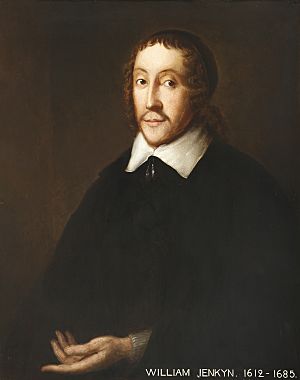William Jenkyn facts for kids
William Jenkyn (1613–1685) was an English clergyman who lived during a time of great change in England. He was a Puritan and a Presbyterian, meaning he had strong beliefs about how the church should be organized. Because of his views, he faced challenges throughout his life, including being imprisoned and losing his job as a minister.
Contents
A Life of Faith and Challenges
Early Years and Studies
William Jenkyn was born in Sudbury, Suffolk, in December 1613. His father, also named William Jenkyn, was a vicar, which is a type of church minister. William's grandfather had disowned his father because of his strong Puritan beliefs.
After his father passed away, William's mother made sure he received a good education. He went to St John's College, Cambridge, in 1628 and later to Emmanuel College. He earned his first degree in 1632 and a master's degree in 1635. Soon after, he began preaching.
Becoming a Minister
Jenkyn first worked as a lecturer in London. In 1641, he became the rector of St. Leonard's in Colchester. However, he moved back to London around 1642 due to illness.
In London, he became the vicar of Christ Church, Newgate, in 1643. He also took on a lectureship at St. Anne's, Blackfriars. Jenkyn was a strong supporter of the Presbyterian way of organizing the church. He even had a public debate with another minister, John Goodwin, about church rules.
Facing Difficult Times
Jenkyn was one of the Presbyterian ministers who spoke out against the trial of King Charles I. He also refused to celebrate the end of the monarchy. Because of this, he lost his church position in 1650 and was stopped from preaching. He moved away for a short time.
Later, he returned to London and became involved in a plan with Christopher Love to bring King Charles II back to the throne. This led to Jenkyn being sent to the Tower of London. He avoided a harsher punishment by writing a very humble letter to the government. After his release, he got his church position back. He also continued to preach at Christ Church and St. Anne's. His popularity grew, and he even preached before Parliament in 1656.
The Great Ejection and Later Imprisonment
Jenkyn welcomed the return of King Charles II in 1660. However, in 1662, a new law called the Uniformity Act of 1662 was passed. This law required ministers to follow strict church rules. Jenkyn, like many other ministers who disagreed with these rules, was "ejected" or forced out of his job.
He preached his last sermons at Christ Church on August 17, 1662. Despite losing his official position, Jenkyn decided to continue his ministry. He held private church meetings, known as conventicles, in 1663. When a new law against these meetings was passed in 1664, he moved to his home in King's Langley, Hertfordshire, and continued to preach there every Sunday.
In 1672, a period of greater religious freedom allowed him to return to London. He opened a new meeting house in Jewin Street. His services were generally allowed until 1682. However, in 1684, he was arrested again while attending a prayer meeting. He was sent to Newgate Prison because he refused to take an oath that would prevent him from trying to change the church or state.
His health quickly worsened in prison. Despite requests for his release due to his poor health, he was not freed. He was even forbidden from praying with visitors, including his own daughter. William Jenkyn passed away in Newgate Prison on January 19, 1685. He was buried in Bunhill Fields burial ground.
Family Life
William Jenkyn was married twice. One of his wives was the daughter of Daniel Rogers. He had one son, also named William. Sadly, his son lost his life in 1685 at about 22 years old, due to his involvement in Monmouth's rebellion.
Writings and Sermons
Jenkyn published many sermons and other writings during his lifetime. These included:
- Sermons preached on various occasions between 1643 and 1675.
- Funeral sermons for other important ministers like William Gouge and Lazarus Seaman.
- The Busie Bishop and The Blind Guide (1648), which were written against John Goodwin.
- Certain Conscientious Queries (1651), where he defended his actions after the plot with Christopher Love.
- An Exposition of the Epistle of Jude (1652-1654), a detailed explanation of a book from the Bible. This work was reprinted several times.
- Celeuma; seu Clamor ad Coelum (1679), a defense of strong language he used in a funeral sermon.
- Refutatio eujusdem Scripti (1681), another defense of his writings.
He also contributed to other books, writing introductions or verses for works by authors like Samuel Clarke and Jonathan Clapham. His farewell sermons from Christ Church were also published.


